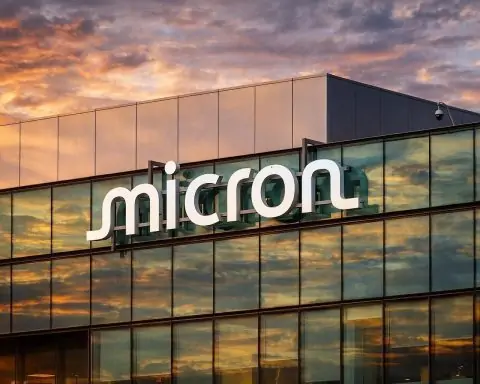Introduction
Advanced Micro Devices (AMD) has emerged as one of 2025’s standout tech stocks, riding a wave of artificial intelligence (AI) and data-center demand. As of mid-November 2025, AMD shares have more than doubled year-to-date, recently hovering around all-time highs [1]. A series of strong earnings reports, ambitious growth targets, and high-profile AI partnerships have fueled investor enthusiasm. This comprehensive analysis covers the latest AMD news in November 2025 – from record-breaking financial results and executive commentary to industry trends and Wall Street outlook – and offers a forecast for AMD’s short- and medium-term stock performance.
Q3 2025 Earnings: Record Growth and Strong Outlook
AMD’s third-quarter 2025 earnings underscored the company’s accelerating momentum. Revenue hit a record $9.25 billion, soaring 36% year-over-year, while net income jumped 61% to $1.24 billion [2]. These results beat analyst expectations (consensus was ~$8.76B in revenue) [3] and were driven by broad strength across AMD’s segments:
- Data Center: Quarterly sales reached $4.3 billion (+22% YoY) thanks to robust demand for 5th-gen EPYC server processors and Instinct MI350 AI accelerators [4].
- Client & Gaming: Combined revenue was $4.0 billion, a massive 73% YoY increase. PC-centric Client revenue hit an all-time high of $2.8B on strong Ryzen chip sales and higher-end product mix, while Gaming (GPUs and semi-custom chips for consoles) surged 181% to $1.3B [5].
- Embedded: This smaller segment saw an $857M revenue, down 8% YoY [6], reflecting some lumpiness in demand after prior growth from Xilinx’s FPGA business.
Notably, AMD’s profitability improved alongside the sales growth. Gross margin expanded to 52%, and operating margin reached 13.7%, up from 10.6% a year ago [7]. Adjusted earnings per share came in at $1.20, slightly topping estimates [8]. Buoyed by strong execution, AMD issued an upbeat outlook for the holiday quarter: Q4 2025 revenue guidance was $9.6 billion at the midpoint, ahead of Wall Street’s ~$9.17B forecast [9]. This implies continued ~30%+ growth into year-end, signaling management’s confidence in sustained demand.
However, there were a few notes of caution. On the Q3 earnings call, AMD acknowledged higher inventory levels (days of inventory rose to 158 from 139 QoQ) as it ramps production for upcoming AI chips [10]. Operating expenses also increased due to aggressive R&D and go-to-market investments [11]. These factors initially made some investors uneasy – AMD’s stock pulled back slightly after the earnings release [12] – as the market digested whether the breakneck growth is fully sustainable. Overall, though, the Q3 results demonstrated AMD’s accelerating trajectory, setting the stage for the strategic moves unveiled shortly thereafter.
AI Partnerships and Product Momentum
Central to AMD’s recent success is its growing footprint in AI and high-performance computing. In October 2025, AMD announced a landmark partnership with OpenAI that immediately put NVIDIA on notice. Under this multi-billion-dollar deal, OpenAI will deploy up to 6 gigawatts of AMD’s GPU capacity – an enormous amount of computing power, “one of the largest compute commitments in AI history,” as observers noted [13]. Instead of going with incumbent NVIDIA, OpenAI chose AMD’s instinct accelerators to scale its AI infrastructure. As part of the alliance, OpenAI also received warrants for up to 160 million AMD shares (roughly 10% of the company) contingent on achieving certain milestones [14]. This unprecedented equity kicker underscores the strategic importance of the collaboration for both sides. For AMD, it not only promises a huge future revenue stream but also serves as validation of its GPU technology in the AI arena.
AMD is also making inroads with cloud giants. Oracle, for instance, has been deploying AMD’s Instinct MI300-series AI GPUs at scale via Oracle Cloud Infrastructure [15]. The AMD–Oracle tie-up, alongside the OpenAI deal, could generate tens of billions in sales in coming years, according to analysts [16]. Moreover, AMD’s tech has been chosen to power cutting-edge government projects: the U.S. Department of Energy tapped AMD’s EPYC CPUs, Instinct accelerators, and Pensando networking for two upcoming supercomputers (“Lux AI” in 2026 and “Discovery” in 2028), a combined $1B initiative to advance AI in scientific research [17]. These high-profile wins showcase AMD’s widening ecosystem of strategic partnerships across the AI and high-performance computing landscape.
On the product development front, AMD’s roadmap is keeping pace with its ambitions. The current Instinct MI350 data center GPUs are ramping faster than any product in company history, according to AMD [18]. Looking ahead, the MI450 “Helios” GPU systems are slated for launch in late 2026, promising “rack-scale” AI performance leadership with industry-leading memory capacity and bandwidth [19]. By 2027, AMD plans to introduce the MI500 series, further expanding its AI performance roadmap [20]. In CPUs, AMD’s next-generation “Venice” EPYC chips are being designed with AI workloads in mind to capitalize on the growing AI-driven demand in servers [21]. Even in consumer PCs, AMD is infusing AI features – its newest Ryzen processors include built-in AI engines, and future CPUs codenamed “Gorgon” and “Medusa” (expected in 2026) aim to deliver up to 10× AI performance gains over 2024 models [22].
In short, AMD is aggressively positioning itself for the AI era across all segments. These partnerships and product launches are not only unlocking new revenue streams but also elevating AMD’s profile as a credible contender to challenge Nvidia’s dominance in accelerators and Intel’s dominance in CPUs. This momentum in AI and high-performance computing has directly fed into AMD management’s confidence – as reflected in the bold long-term targets they revealed this month.
Financial Analyst Day: Bold Long-Term Targets
On November 11, 2025, AMD held its first Financial Analyst Day in three years, and the company did not shy away from lofty goals. CEO Dr. Lisa Su proclaimed that “AMD is entering a new era of growth” driven by its broad product portfolio and “accelerating AI momentum,” asserting “we have never been better positioned” [23] [24]. Backing up that optimism, AMD’s leadership unveiled a “long-term financial model” that wowed investors and sent the stock surging ~7% the next day [25]:
- 35%+ Annual Revenue Growth: AMD is targeting a >35% compound annual growth rate (CAGR) in revenue over the next 3–5 years [26]. For context, AMD’s CFO Jean Hu noted this would represent overall sales jumping from roughly $34 billion in 2025 to dramatically higher levels in coming years [27].
- Data Center & AI as Growth Engines: The data center division (including server CPUs, AI accelerators, networking) is projected to expand at >60% CAGR, reflecting outsized AI-related demand [28]. In fact, AMD set a bold $100 billion annual revenue target just for its data-center business in the long term [29]. Management aims to capture a much larger slice of the AI hardware market currently dominated by Nvidia. In particular, AMD expects its AI-specific revenue to grow >80% annually, leveraging strong customer momentum from deals like OpenAI and next-gen Instinct GPUs [30].
- Market Share Ambitions: AMD believes it can overtake rival Intel in server processors, targeting >50% server CPU revenue market share in the coming years (up from an estimated ~30–40% today) [31]. Likewise, in the PC arena, AMD sees itself exceeding 40% client processor share (gaining further on Intel’s still-large lead) [32]. In adaptive and embedded computing (bolstered by the Xilinx acquisition), AMD is aiming for 70%+ market share in FPGA and adaptive SoC solutions [33].
- Expanding Margins and Earnings: Despite the heavy R&D investments needed to reach these goals, AMD foresees significant margin expansion. The company guided for non-GAAP gross margins in the 55–58% range and operating margins >35% over the next few years [34] – which would be record-high profitability for AMD. By scaling revenues and improving efficiency, AMD is also targeting >$20 in annual EPS (non-GAAP) within 3–5 years [35]. For perspective, Wall Street estimates AMD’s EPS for full-year 2025 at around $2.68 [36], so achieving $20 would imply roughly a sevenfold increase in earnings.
These aggressive targets, if met, would essentially transform AMD into a company several times its current size by the late 2020s. Investors responded very positively to this vision – AMD’s market capitalization jumped by about $26 billion in the wake of Analyst Day [37]. Analysts mostly cheered the new roadmap as well, calling the goals attainable given AMD’s recent big wins. As Reuters reported, industry watchers pointed to the OpenAI and Oracle deals as evidence that AMD can indeed generate the tens of billions in future sales needed to hit such numbers [38]. The notion of a trillion-dollar market for data-center chips by 2030 (AMD’s TAM estimate) further underpins the growth narrative [39].
That said, some seasoned observers injected a note of realism. Bernstein’s Stacy Rasgon described AMD’s targets as “somewhat aggressive/aspirational,” hinging on the company’s ability to evolve from a marginal AI player into a major force [40]. “The jury remains out on that,” Rasgon noted, “but management is clearly going on the offense with the narrative.” [41] In other words, AMD will need to execute flawlessly – especially in capturing AI accelerator market share from Nvidia – to justify its bullish projections. Nevertheless, the tone from AMD’s leadership was resolute. The company effectively told Wall Street that it sees itself becoming a much larger, more profitable organization, fueled by the AI revolution, over the next five years.
Market Sentiment and Investor Response
Investor sentiment around AMD has seesawed at times, but it remains overwhelmingly positive as of November 2025. AMD’s stock price has roughly doubled in 2025, vastly outperforming the broader market and even many other high-flying tech names. By November 12, shares traded around $256, up 112% year-to-date [42] (and up about 139% YTD by some measures [43]). In late October, AMD hit an all-time high near $267 [44] before a brief post-earnings pullback. The AI-fueled rally has put AMD among the top-performing large-cap stocks, thanks to its perceived role as both a beneficiary of the AI boom and a viable challenger to industry incumbents.
Reactions to AMD’s recent news illustrate the market’s enthusiasm. After the Q3 earnings report on Nov. 4, the stock initially dipped ~4% amid profit-taking and some concern over inventory buildup [45]. But any jitters quickly gave way to optimism once AMD’s Analyst Day announcements hit. On Nov. 12, AMD shares surged about 7% in one session, adding over $25B in market value [46], as investors cheered the company’s bold AI-driven growth plan. The stock’s rally since early October – roughly +16% from Oct. 6 to mid-November [47] – has been attributed in part to excitement around the OpenAI partnership (announced Oct. 6) and generally rising confidence that AMD will grab a meaningful slice of the AI spending wave.
At its current price around the mid-$250s, AMD carries a rich valuation – about 79× trailing earnings as of Nov. 12 [48]. This reflects substantial growth expectations. Some analysts and investors caution that euphoric sentiment could be overestimating near-term AI sales, raising the risk of an “AI bubble” in chip stocks [49]. Indeed, any hiccup in execution or a slowdown in AI infrastructure spending could spark volatility for high-multiple names like AMD. It’s worth noting that Nvidia’s stock (by far the AI leader) remained unfazed by AMD’s pronouncements – NVDA actually ticked up 1–2% on the day AMD unveiled its targets [50] – suggesting that the market still views Nvidia’s position as secure in the near term.
Overall, market sentiment toward AMD is bullish but with an undercurrent of caution. The company now has a sizable base of investors who believe in its long-term AI story and CPU gains – this is reflected in a consensus “Moderate Buy” rating on Wall Street [51]. At the same time, skeptics point to the formidable competition and the execution risk embedded in AMD’s sky-high projections. This dynamic sets the stage for how AMD’s narrative may unfold as broader industry trends and rival strategies come into play.
Industry Trends and Competitive Landscape
AMD’s fortunes are tightly linked to the broader semiconductor industry trends, which in 2025 are dominated by the insatiable demand for chips that power AI, cloud computing, and advanced devices. A few key external factors and competitive forces are particularly relevant:
- AI Gold Rush: The scramble to build AI infrastructure is a rising tide lifting (almost) all boats. Hyperscale data center operators (like Amazon, Google, Microsoft) and a multitude of AI startups are pouring money into high-performance CPUs and GPUs. This secular trend is a major tailwind for AMD, which is leveraging its full-stack product lineup (CPUs, GPUs, adaptive chips, networking) to capture AI-related sales. CEO Lisa Su noted that tech giants’ rush to expand AI capacity has kicked off an “infrastructure race” with record capital spending [52]. AMD’s challenge – and opportunity – is to convert more of this industry-wide investment into its own revenue. Its open software ecosystem (ROCm) and willingness to co-design solutions (e.g. custom AI chips for clients like Microsoft or Meta, if those arise) could help it make inroads against Nvidia’s CUDA software lock-in. The stakes are enormous: AMD estimates the data-center chip TAM could reach $1 trillion by 2030 [53], though Nvidia projects an even more bullish $3–$4T opportunity, reflecting its dominance. If overall AI demand stays “insatiable” (to use Dr. Su’s term), there may be room for multiple winners – a positive backdrop for AMD’s growth aspirations.
- PC and Gaming Cycles: While data center is the current star, client computing and gaming remain important to AMD’s business. After a soft period in 2022–2023, the PC market showed signs of stabilization in 2024 and a rebound in 2025, particularly for high-end notebooks and desktops. AMD has been capitalizing on this with its Ryzen CPUs. As Q3 demonstrated, AMD notched record client revenue and major gains in gaming, partly due to new product launches and capturing share from Intel [54]. Additionally, demand for gaming GPUs and game console chips (the PS5 and Xbox Series X|S both use AMD semi-custom SoCs) has been robust, contributing to the 181% gaming segment growth [55]. Broader trends like AI PCs – computers with on-chip AI accelerators for enhanced features – could create new niches where AMD aims to lead (its upcoming AI-enabled PC chips were highlighted at Analyst Day [56]). However, PCs and gaming are cyclical businesses, and a potential economic slowdown or saturation of the upgrade cycle in 2026 could moderate growth. AMD’s forecast of >10% CAGR for its Client & Gaming segment over five years [57] suggests it expects steady, if not spectacular, contributions from consumer markets alongside the headline-grabbing data center business.
- Competition from Nvidia and Intel: AMD faces intense competition on multiple fronts – a fact the company itself acknowledges frankly. In September 2025, an unusual alliance formed: Nvidia and Intel announced a partnership (including a $5 billion Nvidia investment in Intel) to co-develop custom CPU-GPU systems [58]. The goal appears to be leveraging Intel’s x86 CPUs with Nvidia’s GPUs in tightly integrated platforms for both data centers and client devices. AMD, which has long touted its unique position as the only company with high-performance CPUs and GPUs under one roof, could see that advantage eroded if “Team Green” and “Team Blue” successfully join forces. In its latest SEC filings, AMD warned investors that the Nvidia–Intel partnership may “result in increased competition and pricing pressure” and could “materially adversely impact our business, financial condition, and margins.” [59] Specifically, AMD is concerned that a jointly-developed “RTX SoC” (a chip fusing Nvidia GPU technology with Intel processors) could negate AMD’s edge in integrated APU designs, which are used in applications like handheld gaming devices [60]. Moreover, Intel remains a fierce rival in CPUs: AMD notes Intel often uses its market might to “aggressively price its products and target [AMD’s] customers with special incentives,” which can pressure AMD’s unit sales and pricing [61]. On the GPU side, Nvidia’s overwhelming lead in data center accelerators (bolstered by its proprietary CUDA software ecosystem and massive R&D budget) is an uphill battle for AMD. Nvidia’s valuation and resources dwarf AMD’s – at one point in 2025, Nvidia’s market cap approached $5 trillion [62] – allowing it to invest heavily to maintain its dominance. All of this means AMD must execute exceptionally well on product performance and value to carve out more share. The good news for AMD is that competition tends to spur innovation; the rivalry is likely to accelerate new offerings and could benefit customers in the form of better price/performance.
- Other Players and Risks: Beyond the big three, AMD also contends with emerging competitors and industry-wide risks. Apple’s in-house silicon (the M-series chips) has eliminated Apple’s need for AMD’s laptop CPUs or GPUs in Macs, though Apple’s market share in traditional PCs is limited. Arm-based server CPUs from Amazon (Graviton) and others introduce alternatives in the cloud, while custom AI chips from Google (TPUs) and startups (Graphcore, Cerebras, etc.) target specific niches. So far, these haven’t derailed AMD’s growth, but they underscore that the semiconductor landscape is crowded with innovation. Meanwhile, geopolitical and regulatory factors loom in the background: U.S. export restrictions on advanced chips to China could constrain AMD’s ability to address one of the largest markets (Nvidia already faces curbs on its top AI GPUs to China). Additionally, the supply chain – particularly reliance on TSMC for cutting-edge fabrication – remains a strategic consideration for AMD. Any capacity bottlenecks or delays at foundries could impact AMD and its competitors alike. (Notably, there are even reports that AMD has explored using Intel’s foundry for some chip production as part of industry collaborations [63].)
In summary, AMD operates in a fast-growing yet fiercely contested environment. The surging demand for AI and computing horsepower is a powerful tailwind in the near and medium term. However, AMD faces heavyweight rivals in Nvidia and Intel (and their new alliance), each determined to defend their turf. How well AMD navigates this landscape – balancing cooperation (e.g. supplying chips to cloud partners) with competition, ensuring adequate supply, and continuing to innovate – will heavily influence its stock performance going forward.
Wall Street’s View: Analyst Ratings and Forecasts
Wall Street analysts have taken notice of AMD’s strong execution and ambitious roadmap. The consensus rating on AMD is currently a “Buy” or moderate Buy, reflecting general optimism about the company’s direction [64]. However, price target estimates vary widely, mirroring the range of possible outcomes for AMD’s story. As of mid-November, analyst 12-month targets span roughly $200 on the low end to $300+ on the high end [65]. A few recent examples highlight the sentiment:
- Evercore ISI reaffirmed its bullish stance, raising its price target from $270 to $283 after the Analyst Day, while maintaining an Outperform rating [66]. Mizuho did similarly, lifting its target to $285 [67]. These increases suggest confidence that AMD’s new AI initiatives will translate into higher earnings.
- Rosenblatt Securities is among the more optimistic, holding a Buy rating with a $300 target [68]. Wedbush also sees substantial upside, recently reiterating an Outperform with a $290 target [69].
- Not every firm is unabashedly bullish. Morgan Stanley, for instance, has kept an Equal-Weight (neutral) rating with a more tempered $260 target [70], essentially around the current trading price. This implies AMD may already be fairly valued unless it delivers further upsides.
- Goldman Sachs and other analysts have pointed out that while AMD’s AI opportunity is real, Nvidia remains the dominant player – hence some are in “wait-and-see” mode regarding AMD’s ability to hit its lofty forecasts [71]. The broader analyst consensus as reported leans positive, but acknowledges execution risks; one survey pegs the average target near ~$240–$250, which is just slightly below where the stock trades [72].
Importantly, analysts have been upwardly revising their estimates following AMD’s announcements, a sign of building confidence. The stock’s huge year-to-date run has likely been supported by these improving outlooks. Still, the disparity between the most bullish targets (around $300 or higher) and the cautious ones (around $200) indicates uncertainty on how much of AMD’s future success is already priced in. Some forward-looking analyses even speculate about multi-year upside – for example, a recent Nasdaq commentary argued that AMD’s investments in AI could potentially drive the stock above $500 within five years, if all goes well [73]. That, however, is a highly optimistic scenario requiring AMD to meet or exceed its long-term goals.
For now, investors can take comfort that professional sentiment is generally on AMD’s side. We have witnessed a wave of target hikes, and phrases like “further upside” are common in analyst notes post-November 2025 [74]. The key for AMD will be converting this goodwill into tangible results – keeping revenue and earnings on the steep trajectory that its CEO has promised. Wall Street will be watching upcoming quarters closely to see if AMD’s AI wins turn into meaningful financial contributions and if its competitive position continues to strengthen.
Short-Term Outlook (Next 3–6 Months)
In the short term, AMD’s stock performance will likely be driven by its execution through the rest of 2025 and early 2026, as well as overall market sentiment toward tech. Several factors paint a constructive near-term picture:
- Strong Year-End Demand: AMD’s above-consensus Q4 guidance ( ~$9.6B revenue [75] ) suggests that Q4 could mark another record quarter. The holiday season typically boosts gaming-related sales (consoles, GPUs), and enterprise customers often finalize budget spend – potentially lifting data center chip orders. Analysts will look for AMD to hit or exceed this outlook when it reports Q4 results (likely in late January 2026). If the company delivers a positive surprise or issues upbeat guidance for Q1 2026, that could further support the stock.
- AI Revenue Ramp: While AMD’s massive OpenAI deal may take time to ramp (the 6 GW of GPUs will be deployed over several quarters or years), any early revenue from AI wins could start appearing in late Q4 2025 or Q1 2026 results. For instance, if AMD begins shipping MI300 accelerators to OpenAI or other cloud clients in volume, investors will want to see evidence of that traction. Even anecdotal wins – e.g. a new cloud customer announced, or positive benchmarking data on AMD’s MI300 versus Nvidia’s H100 – could bolster confidence that AMD’s AI strategy is gaining steam.
- Stock Momentum & Technicals: With AMD shares up ~100%+ this year, some consolidation or profit-taking is possible, but the stock has shown strong momentum. It is part of the so-called “Magnificent Seven” group of leading tech stocks, and inclusion in major indices and year-end portfolio rebalancing might keep demand high. Barring any external shock, AMD could continue to trade in an elevated range. However, investors should be mindful of broader market factors – for example, any spike in interest rates or rotation out of tech could temporarily pressure high-valuation stocks like AMD.
- Risks to Watch: In the immediate term, one risk is inventory digestion. AMD’s inventory build hints that it is manufacturing ahead of demand in anticipation of big orders (especially for new AI chips). If those orders (from, say, hyperscalers) are slower to materialize in early 2026, AMD might have to moderate production, which can impact margins. Additionally, competitive product launches are on the horizon: Nvidia is expected to unveil next-gen GPUs (possibly the Blackwell architecture) in 2026, and Intel is launching new server and PC processors. Any leapfrogging in performance by competitors could sway customer decisions in the near term. Lastly, macroeconomic news – such as signs of enterprise IT spending tightening – could quickly shift sentiment even if AMD’s individual execution is solid.
Bottom line (short-term): AMD enters late 2025 with significant momentum. Barring a broad market downturn, the next few months could see AMD stock holding its recent gains or even pushing higher if the company continues to meet growth expectations. In particular, successful execution on Q4 and signs of AI revenue acceleration in early 2026 would likely be positive catalysts. Short-term volatility is always possible (especially around earnings dates), but AMD’s recent track record and guidance instill a fair degree of confidence for the immediate future.
Medium-Term Outlook (2026–2027)
Looking further out, the medium-term forecast for AMD is optimistic yet highly contingent on execution. Over the next 1–3 years, AMD aims to transition from fast follower to a true leader in multiple markets. Whether the stock can continue its ascent will depend on how reality measures up to expectations:
- Growth Trajectory: AMD’s own target is ~35% compound annual growth for the next several years [76]. Achieving even a substantial portion of this would mean revenues doubling roughly every two years – an extraordinary pace for a large-cap company. If AMD can, for instance, grow from ~$34B in 2025 to, say, ~$70B+ by 2027, the earnings leverage could be enormous (given improving margins). In that scenario, the stock would likely appreciate significantly beyond current levels. Some analysts have modeled that AMD’s EPS could approach $10 by 2027 and continue rising thereafter, which would support a much higher share price in the long run. On the other hand, any notable deceleration (e.g. growth slipping to low double digits after 2025) might lead to multiple compression, since the current valuation is predicated on high growth. Investors should watch the year-over-year growth trend each quarter; as the numbers get larger, sustaining 30%+ gains will be challenging and any guidance misses could jolt the stock.
- AI Market Share: A critical medium-term swing factor is how much AI accelerator market share AMD can capture. Nvidia today commands the lion’s share (>80% by some estimates) of data center AI GPUs. AMD doesn’t need to beat Nvidia outright, but to justify its 80%+ AI segment CAGR goal [77], AMD must carve out a significant niche. By 2026–2027, we will have proof points: the performance and adoption of AMD’s MI300/MI350 GPUs (and the 2026 MI400 series) in real-world AI workloads. If by 2027 AMD is powering a sizable fraction of AI cloud instances or supercomputers – perhaps thanks to deeper partnerships with OpenAI, Meta, Microsoft, or government projects – it will validate the investment thesis. Conversely, if Nvidia’s next-gen offerings keep AMD perpetually one step behind, AMD might remain a second source rather than a primary choice for AI – tempering its upside. Notably, AMD is also exploring custom silicon (potentially leveraging Xilinx FPGA tech or semi-custom designs) to cater to specific AI customers; any breakthroughs there could differentiate it from Nvidia. The software ecosystem will also be key: continued improvements to ROCm (AMD’s open-source answer to CUDA) and developer support in the next couple of years are necessary for broader AI adoption of AMD hardware.
- CPU Leadership and Competition: In CPUs, the medium term will determine if AMD can sustain its gains against Intel. AMD’s Zen architecture has been a leapfrog story, but Intel is fighting back with new designs (like Meteor Lake and beyond for client, and Sierra Forest/Granite Rapids for server). AMD’s target of >50% server share implies stealing major business from Intel [78]. By 2027, we’ll likely see whether AMD’s bet on chiplet architectures and aggressive core counts (EPYC “Venice” and successors) has indeed made it the majority leader in data centers. Intel’s execution (or lack thereof) will factor in – if Intel stumbles on manufacturing or product timing, AMD can capitalize further. If Intel executes well, the CPU battle could become a harder fought stalemate. Meanwhile, the Nvidia-Intel partnership might yield its first fruits in a couple of years. If by 2027 Nvidia and Intel release a hybrid CPU-GPU product that gains traction (for example, an Intel CPU with tightly integrated Nvidia AI acceleration for cloud customers), that could potentially cut into some of AMD’s combined CPU/GPU sales. AMD’s medium-term success will thus rest on continuous innovation – delivering superior CPU performance per watt, and perhaps offering seamless CPU-GPU solutions of its own (one advantage of housing both under one company).
- Financial Outcomes: AMD’s financial baseline in 2025 (around $2.50–$3.00 EPS) could multiply over the medium term if its plans play out. For instance, AMD set a >$20 EPS goal on a 3–5 year horizon [79]. Even if it achieves half of that by 2027 (~$10 EPS), the stock would have substantial room to run. In a scenario where growth projects materialize slower, AMD might land at a more modest ~$5–$6 EPS by 2027. The market’s view of AMD in 2026–2027 will largely hinge on how close the company appears to be tracking toward its long-term targets. Any signs of hitting milestones (like reaching 40–50% server CPU share, or racking up, say, $1B+ quarterly in AI GPU revenue) would be very bullish indicators. The company’s own capital allocation will be interesting to watch too: with growth comes cash flow, so AMD might start considering stock buybacks or bigger acquisitions in a few years, which could influence stock supply and investor perception.
- Risks in Medium Term: Potential headwinds include the ever-present cyclical nature of semiconductors – an oversupply or downturn in tech spending by 2027 is possible, which could compress margins industry-wide. Geopolitics remains a wildcard (e.g. U.S.–China tech tensions might intensify, impacting market access or supply chains for AMD). And, as stressed, competition is the big unknown: by 2027 we’ll know if Nvidia’s dominance was unassailable or if AMD successfully grabbed a seat at the AI table; likewise, if Intel’s resurgence succeeded or if AMD solidified its lead in servers. Investors should be prepared for a wider range of outcomes in the medium term – AMD could be a much larger company if all goes right, but disappointments could also mean the stock settles into a lower growth profile.
Bottom line (medium-term): The next couple of years are likely to be transformational for AMD. The optimistic case sees AMD continuing to fire on all cylinders – double-digit revenue growth, expanding margins, and rising market share – which could propel the stock substantially higher by 2027, potentially into new record territory. More cautious scenarios, where growth moderates or competition eats into AMD’s plans, could result in a more muted stock performance or higher volatility. Given management’s bold roadmap, a lot is expected of AMD; for investors, it will be critical to monitor execution against those targets. As one analyst put it, AMD’s management is “going on the offense” [80] – the coming years will reveal how effective that offense is in the face of heavyweight rivals.
Conclusion: What Lies Ahead for AMD Investors
As of November 2025, AMD stands at a pivotal moment. The company has shaken off its underdog status and is now a $400+ billion tech heavyweight, thanks to savvy product execution and the rising tide of AI-driven demand. Recent developments – blowout earnings growth, major AI partnerships, and an audacious five-year plan – suggest that AMD’s leadership is intent on closing the gap with, or even surpassing, its larger competitors in key markets.
For investors, AMD offers a compelling but challenging proposition. On one hand, the growth story is highly attractive: robust demand across PCs, gaming, and especially data-center AI could keep AMD on a trajectory of expanding sales and profits for the foreseeable future. The company’s moves (like teaming with OpenAI and others) position it as a central player in the next chapter of computing. If AMD delivers on even a portion of its stated goals – for example, capturing half of the server CPU market and significantly denting Nvidia’s stranglehold on AI accelerators – the upside could be substantial. It’s not inconceivable that AMD’s stock will continue to outperform, given the positive sentiment and recent analyst upgrades (several now see the stock in the high-$200s or above [81]).
On the other hand, expectations are now sky-high. AMD’s valuation already bakes in a lot of future success, and the firm is entering a phase of execution where any slip-ups could be costly. The competitive responses from Nvidia and Intel will intensify – AMD itself warns of increased pressure from their alliance [82]. Investors should be prepared for potential turbulence if, for instance, a product launch is delayed or a big customer win falls through. Risk management is key: diversifying one’s portfolio and not over-allocating to any single momentum stock is prudent, even for a strong performer like AMD.
In summary, the outlook for AMD’s stock remains bright but will require careful navigation. In the short term, momentum and fundamentals appear solidly in its favor. In the medium term, the company’s bold bets on AI and continued innovation will determine if AMD can truly join the ranks of the mega-cap leaders in tech. For now, AMD has given investors plenty of reason for optimism – a view encapsulated by CEO Lisa Su’s confidence that AMD is “uniquely positioned to lead the next generation of high-performance and AI computing” [83]. The coming quarters will show how well that confidence translates into reality. Investors should watch those developments closely, but as of November 2025, AMD’s story is one of remarkable growth, strategic ambition, and cautious hope that the best is yet to come.
Sources:
- AMD Q3 2025 financial results and segment performance [84] [85]
- Financial Analyst Day 2025 announcements (35% CAGR target, margin and EPS goals) [86] [87]
- Executive commentary (Lisa Su quotes and CFO projections) [88] [89]
- Reuters – AMD shares rise as investors cheer AI-driven revenue growth targets [90] [91]
- Motley Fool via Nasdaq – AI Skeptics Could Be Wrong, and This Stock Still Has Room to Run [92] [93]
- Watcher.Guru – AMD stock booms 8% on bullish 5-year guidance [94] [95]
- Benzinga – Analysts See Further Upside (Evercore, Mizuho, etc. price target increases) [96]
- Tom’s Hardware – AMD warns Intel–Nvidia partnership is a risk [97] [98]
- Finviz/StockStory – AMD Q3 2025 earnings call highlights (estimates beat, guidance) [99] [100].
References
1. www.nasdaq.com, 2. www.nasdaq.com, 3. finviz.com, 4. www.nasdaq.com, 5. www.nasdaq.com, 6. www.nasdaq.com, 7. finviz.com, 8. finviz.com, 9. finviz.com, 10. finviz.com, 11. finviz.com, 12. finviz.com, 13. www.nasdaq.com, 14. www.nasdaq.com, 15. ir.amd.com, 16. www.reuters.com, 17. www.nasdaq.com, 18. www.webull.com, 19. ir.amd.com, 20. ir.amd.com, 21. ir.amd.com, 22. ir.amd.com, 23. ir.amd.com, 24. www.webull.com, 25. www.reuters.com, 26. ir.amd.com, 27. watcher.guru, 28. ir.amd.com, 29. www.reuters.com, 30. ir.amd.com, 31. ir.amd.com, 32. ir.amd.com, 33. ir.amd.com, 34. www.webull.com, 35. ir.amd.com, 36. www.reuters.com, 37. www.reuters.com, 38. www.reuters.com, 39. www.reuters.com, 40. www.reuters.com, 41. www.reuters.com, 42. www.nasdaq.com, 43. watcher.guru, 44. www.nasdaq.com, 45. finviz.com, 46. www.reuters.com, 47. www.reuters.com, 48. www.nasdaq.com, 49. watcher.guru, 50. www.reuters.com, 51. www.nasdaq.com, 52. www.reuters.com, 53. www.reuters.com, 54. www.nasdaq.com, 55. www.nasdaq.com, 56. ir.amd.com, 57. ir.amd.com, 58. www.tomshardware.com, 59. www.tomshardware.com, 60. www.tomshardware.com, 61. www.tomshardware.com, 62. www.tomshardware.com, 63. www.tomshardware.com, 64. www.nasdaq.com, 65. watcher.guru, 66. www.webull.com, 67. www.webull.com, 68. www.webull.com, 69. www.webull.com, 70. www.webull.com, 71. www.reuters.com, 72. www.investing.com, 73. www.fool.com, 74. www.webull.com, 75. finviz.com, 76. ir.amd.com, 77. ir.amd.com, 78. ir.amd.com, 79. ir.amd.com, 80. www.reuters.com, 81. www.webull.com, 82. www.tomshardware.com, 83. www.webull.com, 84. www.nasdaq.com, 85. www.nasdaq.com, 86. ir.amd.com, 87. www.webull.com, 88. ir.amd.com, 89. watcher.guru, 90. www.reuters.com, 91. www.reuters.com, 92. www.nasdaq.com, 93. www.nasdaq.com, 94. watcher.guru, 95. watcher.guru, 96. www.webull.com, 97. www.tomshardware.com, 98. www.tomshardware.com, 99. finviz.com, 100. finviz.com







